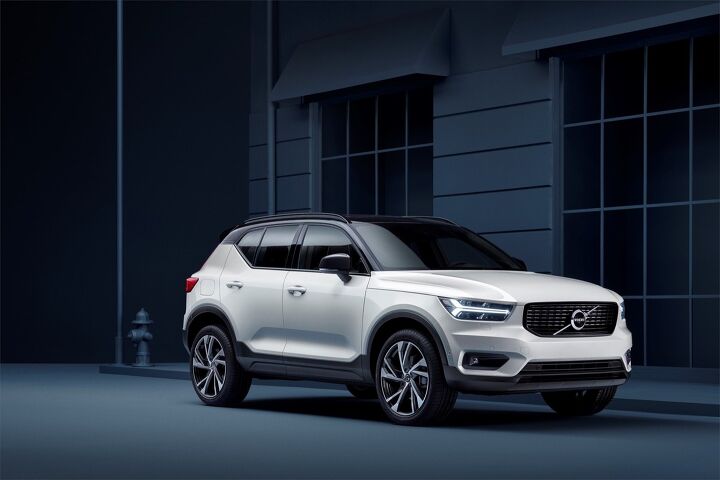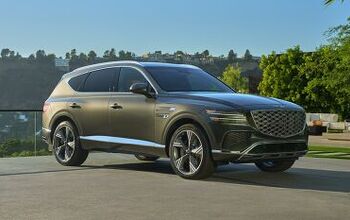What's the Volvo XC40 Getting Into? America's Subcompact Luxury Crossover Segment Is Tiny But Growing Fast
Of the 1.4 million new vehicles sold in the United States of America each month, premium auto brands account for slightly more than one out of every ten new vehicle acquisitions.
More than 55 percent of the vehicles now sold by premium auto brands in America are utility vehicles. Of the nearly 100,000 luxury SUVs/crossovers sold in America each month, 7 percent are subcompacts, vehicles positioned below the compact BMW X3, Mercedes-Benz GLC, Audi Q5, and a variety others.
It’s a sliver of a slice of a chunk of a pie. But that sliver is growing far faster than the overall U.S. auto market, far faster than the U.S. luxury vehicle market, and far faster than the U.S. luxury SUV/crossover market.
Into that four-vehicle premium subcompact crossover segment now jumps the Volvo XC40, timed to roughly coincide with the arrival of the Jaguar E-Pace. It’s a segment that, to date, no automaker has yet found a way to dominate.
Boosted by last year’s arrival of the Mercedes-Benz GLA-based Infiniti QX30, subcompact luxury crossover sales have grown 31 percent to more than 57,000 units through the first eight months of 2017. That’s a 65-percent gain compared with the first eight months of 2015 and a 304-percent leap since the same period in 2014.
For two years, the first-gen BMW X1 had the category to itself. The Audi Q3 and Mercedes-Benz GLA arrived in the late stages of 2014’s summer, yet BMW X1 sales have not suffered as a result. 2016 was its best year yet. Through the first two-thirds of 2017, X1 sales are up 19 percent.
The X1 is America’s sales leader, but it has not achieved the all-conquering margins of victory accumulated by, say, the Lexus RX. In a four-vehicle category, the X1 has earned 33-percent market share, ahead of the GLA’s 26-percent share, the Q3’s 22-percent share, and the 19-percent share earned by the still-young QX30.
With so many subcompact crossover buyers new to premium brands, there is little built-in loyalty. Consumers are ripe for conquest. Half of all buyers in this category have moved over from a mainstream brand. In other words, when the Jaguar E-Pace and Volvo XC40 arrive in U.S. showrooms, they won’t be fighting over vast swathes of buyers who’ve already committed to the X1, GLA, Q3, or QX30. There are new buyers aplenty. Moreover, the E-Pace and XC40 enter the battle with the freshest faces in the segment, bolstered by resurgent brands.
Responsible for only 4 percent of America’s luxury auto scene so far this year, the subcompact luxury crossover category is undeniably small. Buoyed by more nameplates, average transaction prices in the affordable realm below $40,000, and an anti-car wave that has yet to crest, it surely won’t be small for long.
With so many new buyers and so few competitors, look for Volvo and Jaguar to earn the kind of market share in this segment the two former Ford-owned companies have yet to display in other categories.
[Images: Volvo, Jaguar, BMW, Audi, Mercedes-Benz, Infiniti]
Timothy Cain is a contributing analyst at The Truth About Cars and Autofocus.ca and the founder and former editor of GoodCarBadCar.net. Follow on Twitter @timcaincars and Instagram.
More by Timothy Cain
Latest Car Reviews
Read moreLatest Product Reviews
Read moreRecent Comments
- Lou_BC Well, I'd be impressed if this was in a ZR2. LOL
- Lou_BC This is my shocked face 😲 Hope formatting doesn't fook this up LOL
- Lou_BC Junior? Would that be a Beta Romeo?
- Lou_BC Gotta fix that formatting problem. What a pile of bullsh!t. Are longer posts costing TTAC money? FOOK
- Lou_BC 1.Honda: 6,334,825 vehicles potentially affected2.Ford: 6,152,6143.Kia America: 3,110,4474.Chrysler: 2,732,3985.General Motors: 2,021,0336.Nissan North America: 1,804,4437.Mercedes-Benz USA: 478,1738.Volkswagen Group of America: 453,7639.BMW of North America: 340,24910.Daimler Trucks North America: 261,959





































Comments
Join the conversation
Back in the day....the editor at the time derided the Buick Encore as a sure fire sales failure due to it being based on a subcompact frame. That segment seems to be doing fine today and as I looked at another HRV today, I marveled at how they are starting to look better and better. Mind you that editor also said the Fusion was a game changer.
You are right about these entry level luxury cars appealing to mainstream buyers, at least in my case. It was around 2008 that I was looking for a car to replace my pickup truck for daily driving. I probably would of bought a Subaru, but I found a web site that asked a thousand questions and came up with a recomendation of what car to buy. It added both the Volvo C30 and Audi A3 to the list. They were more than I wanted to spend, but the A3 was just so much better than the Impreza. I finally found a low milage 1 year old model and got it. Today I will tell you it was the best car I ever owned. I would of loved to buy another, but again I'm just not that wealthy.